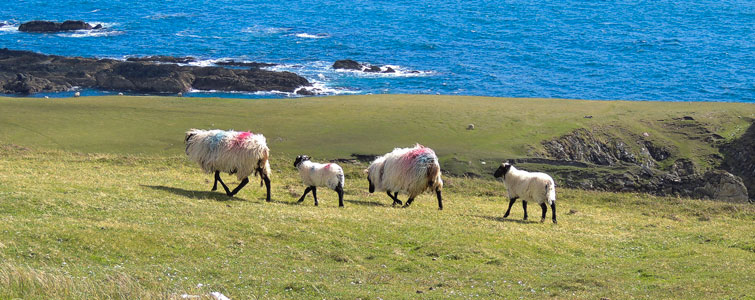Industry, History of Achill Island in Co. Mayo

A little number of small industries were set up on Achill through the centuries but none of them survived.
Flax grew abundantly at Keel Sandbanks, Dookinella and Dooniver. Flax was harvested and spun on the island, there was a flax mill in Dookinella and another one in Keel.
There were also a mill for grinding the corn and a mill for thickening flannel in Belfarsad.
It was said there was a salt factory before the Achill Mission was established in 1833.
On Achill there were four blacksmiths located in Keel, Cabán, Cashel and the Valley and twelve shoemakers which made high quality homemade shoes. In early 1930s’ shoemakers closed down definitely after the coming of cheap shoes on the market.
There were copper and sulphur mines situated in Bolinglanna, Benderg and between Gubroe and Carricknahelty.
Some of the Achill women tried to set up small knitting industries: in Dooagh Miss Eva O’Flahertyran a little business using knitting machines and employed a good number of women. She sold her items all over Ireland.
Dugort women made stockings and flannel. They spun and knitted the coarse wool of their sheep. They used to sell them to Frenchmen coming twice a month to the village.
Seaweed harvesting was an industry along the Mayo’s coast and on Achill Island. Originally seaweed was used as fertiliser for land and later processed for iodine, glass, animal feeds, food additives and cosmetics.
Seaweed rights were important, and they were granted according to the size of the holdings and trying to give access to the sea to all villages along the shore. Usually, the harvesting started on St Patrick’s Day and stretched to the low ebb of the spring tide.
Men and women harvested and tied the seaweed into anchored bundles using short-bladed knives at low tide. The bundles were then collected on the rising tide by curraghs and carried inland in wicker back-baskets called in Irish cliabhanna.
In the nineteen century, fucus farms or seaweed garden were set up. Strips of the seashore were divided and large stones arranged in rows on which seaweed could colonise. It took three years for the seaweed to colonise the boulders before to be harvested. Seaweed could then be mixed with sea-sand to make the “plaggen” soil. Boulders can still be seen at Cloughmore and Derreens.
Some seaweed including carrageen moss, dulse, sloke, dilisk, creannac, cuirdins ( a parsnip shaped weed) has high nutritive value.
During the Great Famine seaweed was used commonly as food and supplemented the diet of the communities on the island, and this is one of the reasons why only a few people in Corraun died during the famine.
